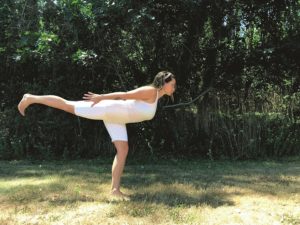“Practice makes perfect” or “10,000 hours to become an expert” — we like to believe that if we do something long enough, we conquer it. Then we can set it down or ride it out the rest of the way. Twenty-year-old me once thought this about yoga. Twenty-five-year-old me thought this about love. Thirty-one-year-old me has learned through anti-racism work that it is all just practice.
None of these is about perfection. They’re about showing up. And being dedicated to learning, making mistakes, and starting all over again.
“Yeah, but you’re a yogi. You can handle it,” a dear friend told me over the phone last year when I was going through a breakup. This wasn’t the first time a well-meaning friend assumed I could handle something because of an imaginary yogic superhero strength. I had been assigned a label. I had become a yogi. But the truth was, I couldn’t handle that breakup. I stopped eating, though I knew better. I stopped meditating, though I knew better.
I can’t stop thinking about how we label each other. Specifically, what attributes we mistakenly assign, not recognizing that these labels are not nouns but repeated practices.
Gently (and sometimes not so gently), I remind people that yoga practitioners do not have an upper hand on dealing with life. Depression, anxiety, tragedy, and stress don’t skip over us like we’re wearing invisibility cloaks. We have a toolbox. Sometimes you open it, sometimes you don’t. Inside live the practices that illuminate, help us deal. If we engage in the practice.
If I am feeling particularly lethargic, I practice breathwork that fires me up — Kapalabhati (loosely translated as Breath of Fire). But when I feel angry, I stay away from fiery practices. Better to stand with my feet wide, teeter forward and back from toes to heels, and then slowly lower myself to the ground.

Sometimes, even seated, it is hard to focus. That’s when standing balancing postures can help. Warrior 3 (or Virabhadrasana III, in Sanskrit) is my go-to. Like a one-legged superwoman, I know it won’t work unless I’m fully present. Balance doesn’t happen if your mind isn’t there.
The hardest part of the practice for me is the stillness. Whether it be in the physical posture, lying down, or sitting in meditation. The sitting with what is. Action, movement, doing — I am successful there. Noticing? Allowing? Not so much.
Yoga is not something any of us become, magically, one day. It is a continual and evolving practice and a temporary state of being.
The same goes for being a partner, boyfriend, girlfriend, or spouse. What would it be like to see romantic partnership as a continual daily practice and not a goal? Actively listening when I’d rather tune out or feel triggered. Remaining compassionate during arguments. “I found love,” is uttered often, but why not, “I practice love”?
Antiracism follows a similar path. We are quick to label each other as “racist” or “not racist” or “antiracist.” Ibram X. Kendi laid out succinctly in his book How to Be an Antiracist that these are not labels but practices. You practice being a racist by committing racist acts, voting for racist policies, engaging in racist conversation, and supporting others who do the same. You practice being an antiracist by doing almost the exact opposite: engaging in antiracist rhetoric and calling out those who do not, voting for antiracist policies, advocating for those who cannot safely practice antiracism, committing acts of antiracism solidarity and action.
Kendi posits that labeling yourself as “not racist” is still upholding the foundations of white supremacy, as it is a practice of inaction. Being “not racist” doesn’t challenge the status quo. There is no practice. It is apathy. It is silence. It is sitting back. So, to be an antiracist? We must practice. Exercise. Like muscles of the body. You don’t bench press once and then declare yourself a champion athlete. You show up every day. You work at it.
If we can view life as a collection of practices, then it might allow us a bit more wiggle room when we mess up. We can forgive ourselves more quickly, turn around and try again. Miss the shot, take it again. There is room for error in a practice. Room for improvement. Room for the human in us.
We are in a difficult time. Can it also be an opportunity to practice, not achieve? Antiracism work. Love. The true work of yoga. I realize to do that would require changing the way I think and talk about practice.
As a “yogi,” I practice self-study, contemplation, and physical embodiment.
As a “partner,” I practice active listening and empathy.
As an “antiracist,” I practice challenging those who are in the non-doing state. Practice speaking with those who hold a different view, background, and experience. Advocate and vote for antiracist policy.
I practice, practice, practice.



